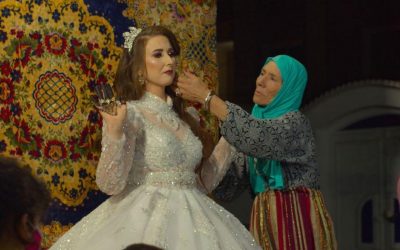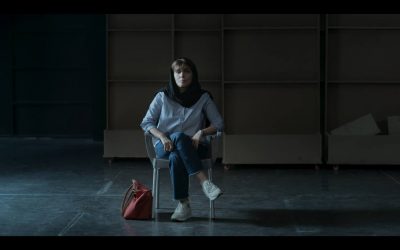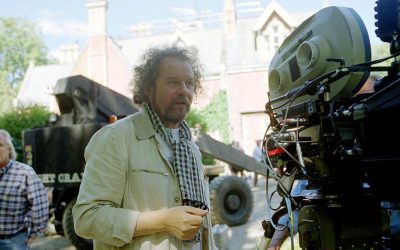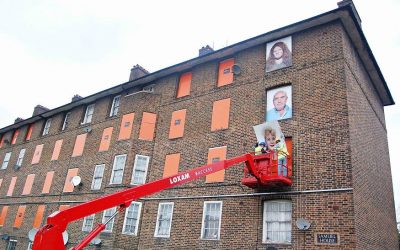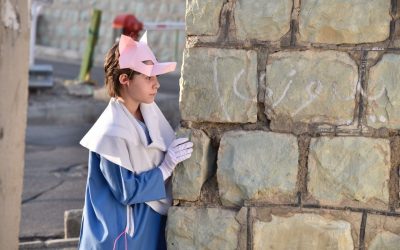By : Isis Nusair
This interview was conducted following the screening of 5 Minutes from Home (2008) in Berlin, Germany in December 2018.
Isis Nusair (IN): How did you start making movies?
Nahed Awwad (NA): It all started by chance, although I was always interested in movies. Unlike today, the options for studying cinema or even going to the movies were not available in Palestine at the time, so I decided to study abroad. I had to submit a short film when I applied for programs. I borrowed a camera and started recording daily life during the Israeli invasion in 2002. I was interested in recording what was happening as we were constantly inside due to the curfews. I ended up collecting a lot of footage of the destruction in Ramallah, including the images of the flattened cars scattered all over the city. That is how I made my first two experimental films, Lions (2002) and Going for a Ride? (2003).
IN: I was very moved when watching your film, Going for a Ride? Those cars flattened by Israeli tanks are engraved in my memory from the 2002 Israeli invasion of Ramallah. The cars looked like bodies piled on top of each other.
NA: The flattened white car in the film is that of my neighbor. These things were happening all around me. People were being killed and there was destruction everywhere. The owner of the flattened yellow taxi was crying over the loss of his car; it was a new car that he needed for his livelihood. His whole future was lost. I had all that footage and wanted to do something with it. Then I heard of Vera Tamari’s project, Going for a Ride? I wanted to document her exhibit and include my footage from the invasion. My film Going for a Ride? is a product of that collaboration.
IN: Your films offer such a poetic representation of the reality around even that of destruction and occupation. You record a moment and simultaneously deconstruct and reconstruct it. Why is it important for you to use documentary film as a medium to communicate with the audience? What connection do you see between documentary filmmaking and memory?
NA: Through my work and research during the 2002 invasion, I used to seek refuge in the camera and at times hid behind it. I needed to create some distance to protect myself. I also wanted to be active and feel that I was doing something. I did not want to only listen to the news. This helped me cope with what was going on. The camera has been accompanying me since then. I made 25 Km (2004) while studying film at the European Film College in Denmark. It was my graduation project. The opening scene is part of my childhood experience at the Allenby Bridge border crossing. I searched for people who looked like us and ended up re-enacting that scene with Palestinians from Syria and Iraqis at a refugee camp in Denmark.
I want to create a conversation between the old and the new, and I want to be a witness to that conversation. I spend a lot of time with the people I film. I learn from them about home, Palestine, and myself. This is different than working with actors. I like to talk and engage with people as well as see things through the lens of a camera. Historically, mainstream Western news media only provided stereotypical representation of Palestinians. People became objects and mere numbers in many of these representations. That is why, in my projects, I usually try to concentrate on one or two characters. I also think of the audience and what they can take away from the film. It is impossible to make a Palestinian film without it being political. The human and the political intertwine in my work. Yet, my entry point is always through people’s stories and daily life.
IN: Your film 5 Minutes From Home deals not only with the political effects of the 1967 occupation of the West Bank and Gaza, but also with the social dimensions of that occupation. It demonstrates the interruption that took place in daily life and social relations in addition to restrictions on freedom of movement.
NA: In the film 5 Minutes from Home, which centers on al-Quds airport, I portray a place that is unknown to many people, especially to the younger generation. The airport was once our window to the world. The photos and the stories I collected from those who worked at the airport are fascinating to me. There were pictures of women with big hats and fluffy dresses. I felt as if I was watching an Egyptian classic film from the 1950s.
IN: 5 Minutes from Home is about a time and place that are no longer there. Is it about nostalgia?
NA: Yes, it is kind of nostalgic. I examine loss without rejoicing the past. I also make up my own reality. I did not know much about the topic and was surprised by what I found. The airport building that stands until today was built by Palestinians and Jordanians when the West Bank was under Jordanian rule. The original, smaller airfield was built by the British for military purposes in the 1920s. It was known as Kolundia Airfield. I remember seeing the Israeli planes on a daily basis in the 1990s as I was traveling from Beit Sahour to work in Ramallah.
During the filming of 5 Minutes from Home, the segregation wall was being built around the airport area. I was able in the past to get close to the airport building and the neighborhood where one of my protagonists lived. Within one year, the wall was completed, and I could no longer cross to the other side. I needed an Israeli permit to do so, which I did not have. I ended up finding a Palestinian cameraperson from Nazareth who had a blue Israeli identity card. When we were filming near the airport fence and the Israeli army approached us, I pretended I was not the director and the cameraperson stepped in when necessary. There are always production problems, and you need to have backup plans because the situation on the ground could get out of hand at any moment. The equipment today is more developed and easier to work with, and that could facilitate some of our work.
IN: We see some of these hurdles and challenges in the making of your film Gaza Calling (2012).
NA: Yes, my plan was to film only in the West Bank. I wanted to show how the only way possible for families to connect is through the phone or internet. When Samer suddenly decided to go back to Gaza, his decision came as a surprise to me. I am Palestinian with a West Bank identity card. I am not allowed to go to Gaza without a permit and it is not possible to get one if you do not work with an international media organization, international NGO, or the United Nations. That is why I had to look for a team in Gaza to film Samer’s return. I contacted a film crew there, and got to know them over email and phone. I paid them for their work but we still had a problem of getting the tapes out of Gaza. In the end, a foreign journalist brought the film with him from Gaza to Jerusalem. The story did not end there, as we needed to find someone to bring the film from Jerusalem to Ramallah!
IN: Your films raise questions about the relation between time and place. The camera breaks the curfew and destroys many of the barriers erected. In Not Just A Sea, you challenge the “security reasons” that prevent you from going to the sea. Despite all the restrictions on freedom of movement in Gaza Calling, people say, “at least there is always the sea.”
NA: When I started making movies this connection was not clear to me. I only wanted to make movies about topics that touched me personally. I guess freedom of movement was always on my mind. It was part of the reality I lived on a daily basis. Making films about this topic was a way for me to protest and challenge this reality that was imposed on me, on us as Palestinians.
IN: There seems to be a very intimate connection between you and the camera, and between you and the characters you film. You do that especially in Not Just A Sea(2006) and in The Fourth Room (2005). The camera is both there and not there in your conversation with Abu Jamil. You even tell him at the end that you are sorry and wonder whether you bothered him with your questions.
NA: I used a small camera in my first short films. That actually allowed me to have a closer relation with the people I worked with. When preparing for my film, The Fourth Room, I used to visit Abu Jamil at least once a week. I visited for months without a camera and observed how he communicated with people. I wanted him to be comfortable with me and the camera since he was protecting something when talking about his four rooms. I actually learned through him about al-Quds airport. He once told me about how he used to fly from there to Beirut and Cairo to buy books for his store.
IN: Your films deal with resistance. Abu Jamil leaves on the ground what the Israeli soldiers break during military incursions. “That way they will not break it again,” he says. He also refuses to build an expensive house so that it is not destroyed or him being forced out of it like in 1948. He clings to these objects and insists on talking about the past. In 25 Km, we see people doing the impossible to not give in to restrictions over their freedom of movement.
NA: In The Fourth Room, Abu Jamil refers to the past as the “good old times.” He tries to preserve these moments by locking them in a room. This might be his way of rejecting the Israeli occupation of the West Bank. He talks about how he used to go in his red Fiat car to Gaza to eat fish. His current daily life under Israeli military control is different with checkpoints separating him from his home village of Deir Ghassaneh. He insists on keeping that red car in front of his house even if it is no longer working. He wants to go back to live at a time where there was no occupation. The minute you enter his shop, you feel you are stepping back into the 1950s. I initially thought that he might refuse to talk to me; he seemed like a reserved man. I was surprised to hear him say during the last interview that taking part in this movie might have helped him overcome some of his traumas.
25km is like a personal diary of my experience crossing checkpoints from my place of work in Ramallah to my hometown in Bethlehem district. I wanted to portray the ability to connect disconnected Palestinian cities in the West Bank: a daily struggle for Palestinians until today. I wanted to disrupt this cycle of endless uncertainty. Like Abu Jamil, telling this story helped me overcome some of my own traumas.
IN: Part of this resistance is showing the Kafka-like situation on the ground. There is a graffiti next to an Israeli road blockade in your film 25 Km that says, “better have pains of peace than agonies of war.” In the film Going for a Ride?, we see an art installation made out of flattened cars. We hear music and Quranic recitals coming out of these destroyed cars with the Psagot Israeli settler colony overlooking this installation. In 5 Minutes from Home, we have two sisters unable to meet although they live ten minutes from each other.
NA: The idea for Gaza Calling emerged after I was crossing the border with my daughter when she was three weeks old. I registered her in my Palestinian identity card, but the name was listed differently in the Israeli system. I learned a lot about people’s registration problems as I was trying to fix my own. In Gaza Calling, the journey of delivering the documents from the Palestinian interior ministry to Beit El colony, where the center for the Israeli military’s so-called civil administration is stationed, should not take more than five minutes by car. It is literally down the road. It takes a lot longer in reality! My initial working title of the film was The Mail, and the “documents’ journey” was inspired by a scene from the surreal film Brazil (1985) by Terry Gilliam.
Norma and her sister were born in the same house next to al-Quds airport. Norma’s sister got married and moved to Ramallah. After the 1967 war, she got a West Bank identity card while Norma was given an East Jerusalem one because the area where she lived was declared by Israel as part of “greater” Jerusalem. Today, walls and checkpoints separate them physically. The sister with the West Bank identity card needs a permit to visit her sister and childhood house that are ten minutes away. Could it get more Kafkaesque than this?
I try to reflect some of these situations of living under occupation. People react differently as they try to deal with the checkpoints and the wall that divide families and disturb social ties. The segregation wall is blocking the view in 5 Minutes from Home. I have my own image of the place based on the film and material I gathered. I make my own reality. I want to deal with freedom and I am always looking for small openings that bring me an array of light in the morning!
IN: How was the film 5 Minutes from Home received?

Nahed Awwad
NA: One of the best screenings of the film took place in Ramallah. I never tailor my films to a certain audience. Yet, for the generation that was born after the 1967 War, our knowledge of al-Quds airport came through the Qalandia checkpoint adjacent to it. The hall was packed with people wanting to see the film. Ironically, we had to delay the screening because the French consul who partly funded the film got delayed at the Qalandia checkpoint! People were engaged during the screening and laughed a lot. They recognized many of those depicted in the pictures. It was like looking at a family album. The French consul was surprised to see this many people laughing at such a sad topic. People were excited to learn about this period of time in this way. A new old chapter had opened to a place that was left out of memory; it is as if it did not exist even if it actually did! I was able later to put together a virtual gallery about the airport at Birzeit University.
IN: How do you navigate through the politics of funding?
NA: I knock on many doors for funding. Clearly, I cannot take money from anyone who could restrict the topics I can cover in my films. There have been new sources of funding emerging including the Arab Culture Fund (AFAQ) that provided partial funding to Gaza Calling. There is no special fund in Palestine dedicated to cinema. Unfortunately, this weakens our ability to make movies when we always have to go into co-production with other countries. There is a small Palestinian culture fund from which I got a grant to make the film about al-Quds airport.
IN: Is there in your view a distinctive Palestinian cinema?
NA: I am optimistic. Although we do not have a cinema industry or cinema fund, there is huge development in filmmaking among this young and professional generation. It could be that the circumstances created a need, a passion for making movies. This is not only about having film schools or Palestinian film festivals. We are representing ourselves and our stories in these movies. Until the 1990s, we did not even have Palestinian television. People used to come from the outside and make films about us. Today, we have a number of venues that teach television and film production at Birzeit University, al-Quds University, and Dar al-Kalima University College of Arts and Culture in Bethlehem.
Palestinian cinema is varied with different modes of production. There are filmmakers from Gaza, the West Bank, inside the green line, East Jerusalem and those in the diaspora. They share their experiences and views, and together produce a rounded vision of Palestinian reality.

![[A scene from Gaza Calling]](https://redcutcollective.com/wp-content/uploads/2024/07/IMAGE-2024-07-30-204521.jpg)
